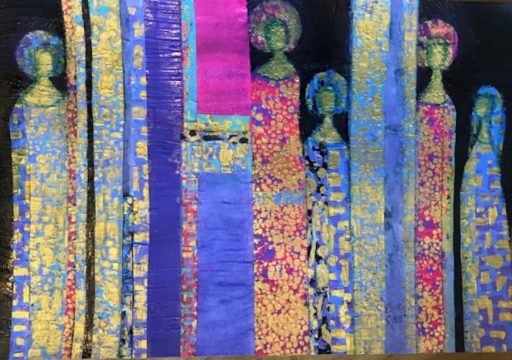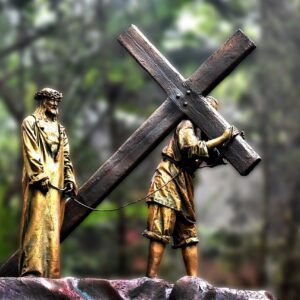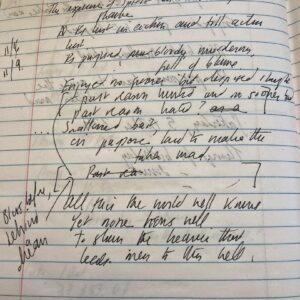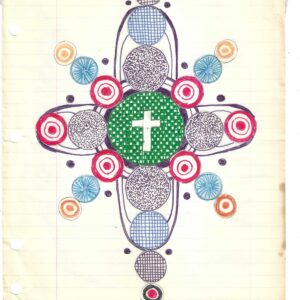The angel Gabriel rolls his eyes at his latest assignment: a virgin in Miami? Can such a creature exist? He goes to the beaches, the design districts, the glittering buildings at every boundary. Just to cover all bases, he checks the churches but finds no vessels for the holy inside.
Finally, Gabriel finds Mary at the community college. But “He no longer hails /
moderns with the standard angel / greetings.” Instead,
The angel Gabriel says a silent benediction and then outlines God’s plan. Mary wonders why Gabriel didn’t go to Harvard where he might find a girl more worthy. What has she done to find God’s favor? She has submitted to many a will greater than her own. Despite a lifetime’s experience of closed doors and the word no, she says yes.
These fun verses are from “A Girl More Worthy,” by Kristin Berkey-Abbott—one of the many poems and visual art works collected for a current Advent exhibit called “Mary, Mary: Contemporary Artists and Poets Consider Mary” at St. Michael’s Episcopal Church in Arlington, VA.
Curator Maureen Doallas, of St. Michael’s Art and Faith Ministry, explains her purpose in mounting this exhibit:
“What might Mary as a contemporary of ours in the 21st Century look like? It is that question that the artworks in this exhibition are intended to answer. The objective?
To prompt a different way of thinking about, perceiving, and seeing Mary,…and reflecting on what she might mean to us in our society today so that we might connect to her in a more intimate way.”
I highly recommend that you visit the entire exhibit here. For this post, I’ll just highlight some of the images that I find especially moving or challenging or delightful.
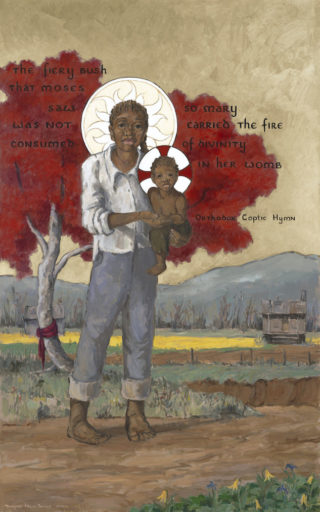
Here in Margaret Adams Parker’s painting “The Burning Bush,” I notice first the desolate landscape and the signs of Mary’s poverty: her rolled-up jeans, her (and the Baby’s) sad faces, looking out at us as if to ask “what will happen to us now?” In Parker’s own statement for the exhibit, she writes that this “African American Christ and Mary,” in their “hardscrabble rural landscape and derelict urban setting…recall the Great Northern Migration [of 1916-1970], when six million African Americans fled oppressive conditions in the rural South in search of a new start.” This painting was inspired, Parker continues, “by an ancient icon depicting Mary as the Burning Bush”—in which “Moses removes his shoes in the presence of the Christ child, who is shown in Mary’s womb, surrounded by flames. The text in my painting is an excerpt from a joyous hymn to Mary as the Burning Bush…: ‘The fiery bush that Moses saw was not consumed; so Mary carried the fire of Divinity in her womb.’ In homage to both the icon and the hymn, I posed Mary against a ‘burning’ tree, a scarlet dogwood, and inscribed Mary’s halo with flames. The spring trout lilies and iris remind us of the traditional symbols for Mary’s purity and her suffering.”
So in “The Burning Bush” we have an ancient iconic tradition re-envisioned for our time.
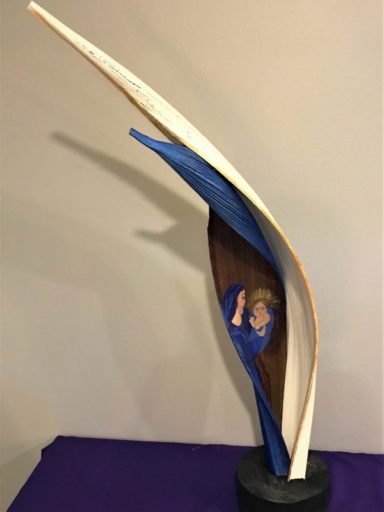 Susan Webb’s sculpture “I Am Blessed” gives us a very different re-envisioning. Webb explains that she chose to paint onto a Royal Palm seed pod “because of its connection to nature. Its functional symbolism is its resiliency and enduring quality to withstand the elements. Surrounding Mary and Child with the white palm pod represents God’s protection of both mother and baby. The iconic color blue can be interpreted to represent Mary’s purity, grace, and divine station in life.”
Susan Webb’s sculpture “I Am Blessed” gives us a very different re-envisioning. Webb explains that she chose to paint onto a Royal Palm seed pod “because of its connection to nature. Its functional symbolism is its resiliency and enduring quality to withstand the elements. Surrounding Mary and Child with the white palm pod represents God’s protection of both mother and baby. The iconic color blue can be interpreted to represent Mary’s purity, grace, and divine station in life.”
I love how Mary’s blue dress melds into the natural world (the pod) that surrounds and encloses her and the Child—imaging Mary’s oneness with the entire universe that God has created.
Finding Mary in this wholly unexpected place — a seed pod — reminds me of another of the exhibit’s poems, “The Virgin Mary Appears in a Highway Underpass,” by Collin Kelley, which begins:
Mary pops up in the strangest places, usually as a window stain or sandwich, but yesterday she dripped down the wall of a Chicago underpass, brought the faithful running with candles and offerings, blocked traffic.
Those “faithful / running with candles” then draw me to the painting at the top of this post: Elise Ritter’s “All Adore Mother Mary.” The figures adoring Mary aren’t running, but they do appear candle-like, straight up as they are, and shining with brilliantly gold specks. To my eye, they burn with adoration. Since they’re abstract, they can represent people through the ages as well as us today, all counting on Mary for solace and protection.
And speaking of solace, another of the exhibit’s paintings images this naturalistically: Janet McKenzie’s “Holy Mother of Comfort and Solace”:
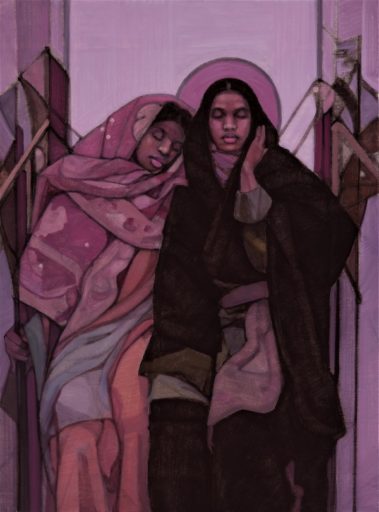 McKenzie writes:
McKenzie writes:
“Over the recent past, Covid-19 stole away our beloveds. Every part of our collective soul hurts, and it is impossible to absorb the concept of how many have died and been taken from us so quickly across the country and the world.
“This profoundly sad time of dying reminds us evermore and once again how much we need unconditional love and hope. Beloved Mother Mary, who has embodied the feminine spirit across time, remains a steadfast and comforting presence to this young woman who rests her head on Mary’s shoulder. We all are this young woman, each of us needing familiar maternal reassurance and a place to rest our own weary heads.”
Yes, I nod. Yes and yes. Looking at this painting, I do identify with this young woman. Hiding from Covid has exhausted me. So has all the violence of our troubled country and world. Resting my head on Mary’s shoulder is, yes, a welcome solace.
Yes. In that word I also hear Mary’s assent that changed the world for us. And so of course this exhibit includes poems on the Annunciation — like the poem I began this post with, and like Laurie Klein’s “Displacement.” Klein’s speaker first pictures
the folded wings, the terrible luminosity speaking, replacing fear, rinsing her room with light.
Then the speaker turns to her own (our own) situation, sighing “Dear maiden,
so many of us still await // our becoming.” But the awaiting turns violent, imagining our current life visited by the angel:
Weather lobs another grenade: the sky rushes in, supplanting steeples, rooflines, shattered foundations. Women stagger through rubble on twig feet. Yet, finally, the speaker turns to address Mary quietly: You, little house of water and bone, married dread’s magnitude: for us, you carried the untold weight of Yes, a body most holy.
That “untold weight of Yes“: still transforming our world totally, as it did over two millennia ago.
+++++++++++++++++++++++++++++++++++++++
Art works credits:
Ritter, Elise. “All Adore Mother Mary”. © 2021. Collage and Acrylic with Rice Papers. 18″ x 24″. By Permission of the Artist.
Parker, Margaret Adams. “American Diptych — The Burning Bush”. © 2021. Acrylic on Dibond Panels. 48″ x 30″. By Permission of the Artist.
Webb, Susan. “I Am Blessed”. © 2021. Palm Fronds and Acrylic Paints. 44″ h; Cement Base, 8-1/2″. By Permission of the Artist.
McKenzie, Janet. “Holy Mother of Comfort and Solace”. © 2019. Oil on Canvas. 36″ x 48″. By Permission of the Artist.
++++++++++++++++++++++++++++++++++++++++
Peggy Rosenthal has a PhD in English Literature. Her first published book was Words and Values, a close reading of popular language. Since then she has published widely on the spirituality of poetry, in periodicals such as America, The Christian Century, and Image, and in books that can be found here.

